外研版(2019)选择性必修第一册 Unit4 Meeting the muse Using language精品课件(共18张PPT)
文档属性
| 名称 | 外研版(2019)选择性必修第一册 Unit4 Meeting the muse Using language精品课件(共18张PPT) | 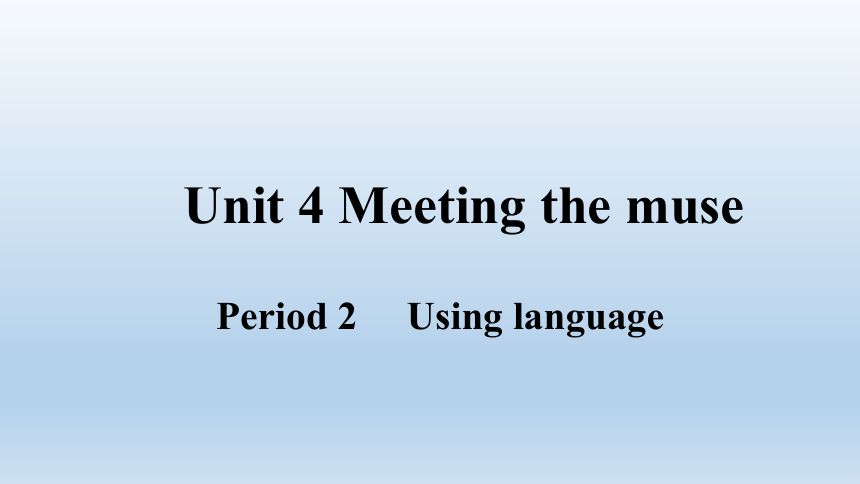 | |
| 格式 | pptx | ||
| 文件大小 | 279.2KB | ||
| 资源类型 | 教案 | ||
| 版本资源 | 外研版(2019) | ||
| 科目 | 英语 | ||
| 更新时间 | 2023-03-02 16:57:02 | ||
图片预览

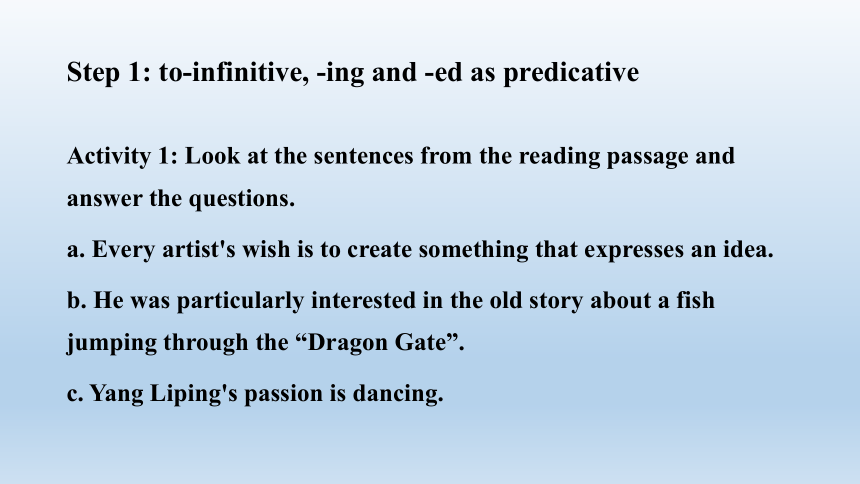
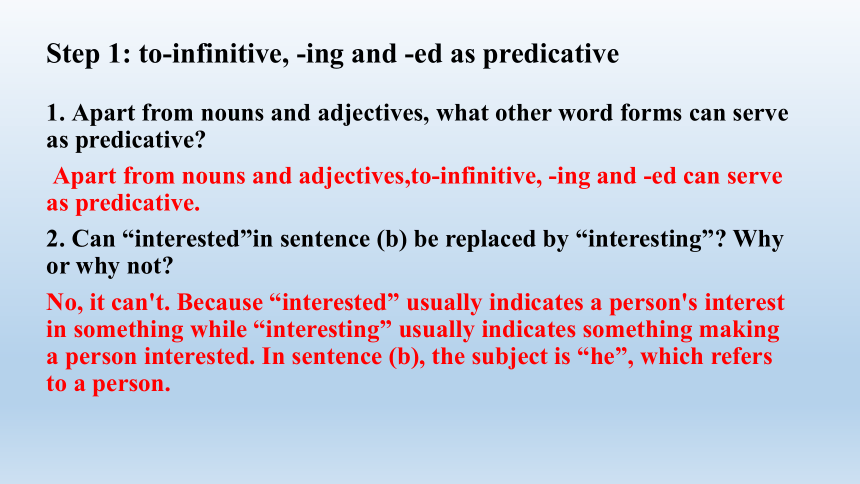
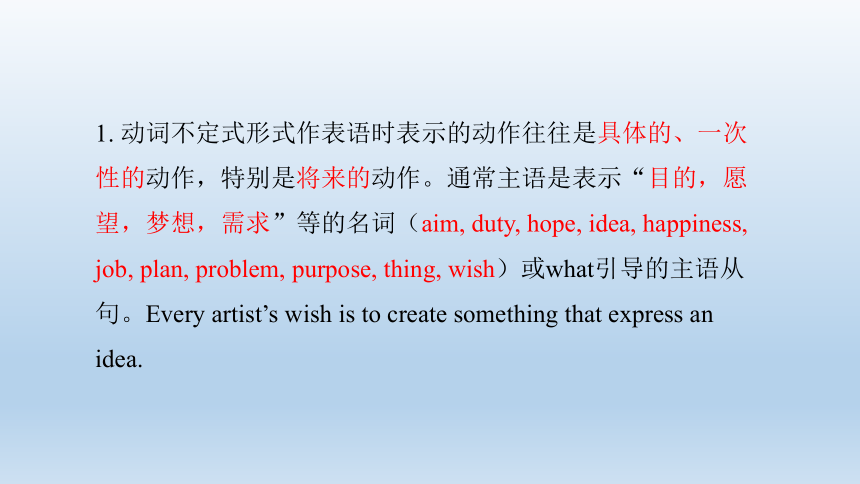
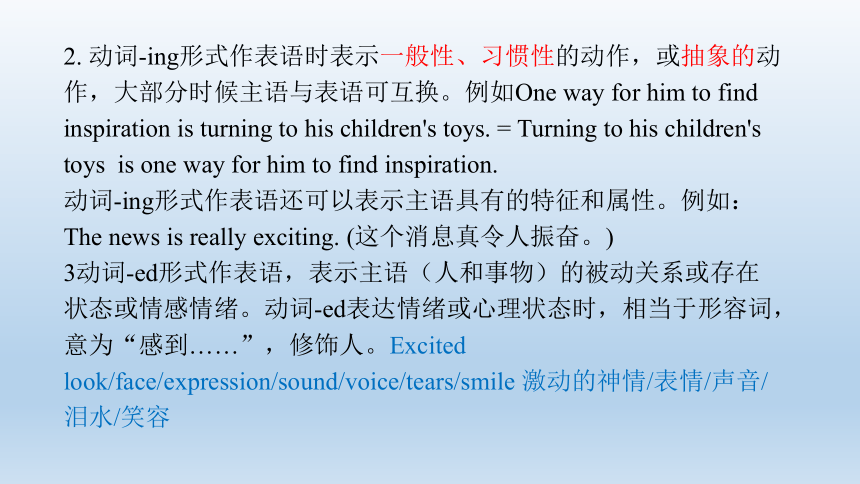

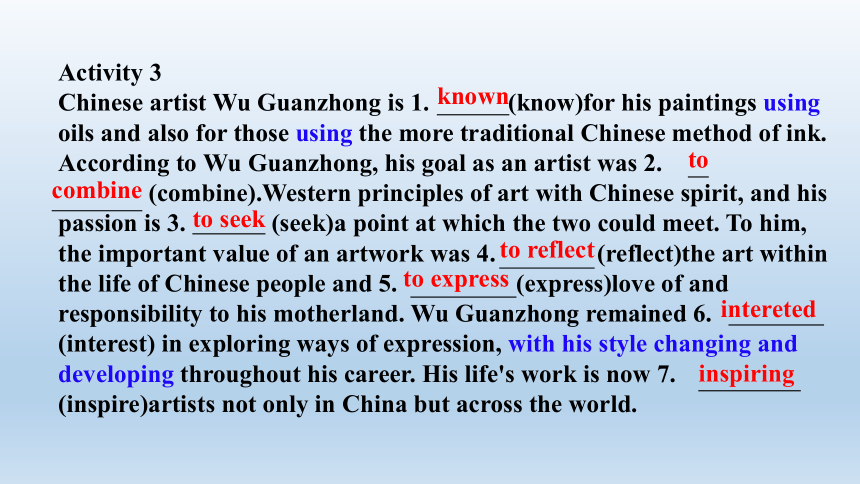
文档简介
(共18张PPT)
Unit 4 Meeting the muse
Period 2 Using language
Step 1: to-infinitive, -ing and -ed as predicative
Activity 1: Look at the sentences from the reading passage and answer the questions.
a. Every artist's wish is to create something that expresses an idea.
b. He was particularly interested in the old story about a fish jumping through the “Dragon Gate”.
c. Yang Liping's passion is dancing.
Step 1: to-infinitive, -ing and -ed as predicative
1. Apart from nouns and adjectives, what other word forms can serve as predicative
Apart from nouns and adjectives,to-infinitive, -ing and -ed can serve as predicative.
2. Can “interested”in sentence (b) be replaced by “interesting” Why or why not
No, it can't. Because “interested” usually indicates a person's interest in something while “interesting” usually indicates something making a person interested. In sentence (b), the subject is “he”, which refers to a person.
1. 动词不定式形式作表语时表示的动作往往是具体的、一次性的动作,特别是将来的动作。通常主语是表示“目的,愿望,梦想,需求”等的名词(aim, duty, hope, idea, happiness, job, plan, problem, purpose, thing, wish)或what引导的主语从句。Every artist’s wish is to create something that express an idea.
2. 动词-ing形式作表语时表示一般性、习惯性的动作,或抽象的动作,大部分时候主语与表语可互换。例如One way for him to find inspiration is turning to his children's toys. = Turning to his children's toys is one way for him to find inspiration.
动词-ing形式作表语还可以表示主语具有的特征和属性。例如:The news is really exciting. (这个消息真令人振奋。)
3动词-ed形式作表语,表示主语(人和事物)的被动关系或存在状态或情感情绪。动词-ed表达情绪或心理状态时,相当于形容词,意为“感到……”,修饰人。Excited look/face/expression/sound/voice/tears/smile 激动的神情/表情/声音/泪水/笑容
Acticity2: Underline the predicatives.
to see
tired
determined
called
sure
there
amazing
wide
parted
1. 强调句It was/is+强调部分+that(人/who)+剩下部分;去掉”It was/is…that…”成分完整。
2. 非谓语做后置定语,相当于who were waiting…,在这里现在分词形式表进行
3. look over one’s shoulder 回头看
4. 虚拟语气,好像她要讲话一样,对将来的虚拟,从句可用were(about)to do ; did; should do.
Activity 3
Chinese artist Wu Guanzhong is 1. known(know)for his paintings using oils and also for those using the more traditional Chinese method of ink. According to Wu Guanzhong, his goal as an artist was 2. to combine(combine).Western principles of art with Chinese spirit, and his passion is 3. to seek (seek)a point at which the two could meet. To him, the important value of an artwork was 4. to reflect(reflect)the art within the life of Chinese people and 5. to express (express)love of and responsibility to his motherland. Wu Guanzhong remained 6. intereted (interest) in exploring ways of expression, with his style changing and developing throughout his career. His life's work is now 7. inspiring (inspire)artists not only in China but across the world.
known
to
combine
to seek
to reflect
to express
intereted
inspiring
With复合结构:with+宾语+宾补;
With+ 名词/代词 + doing/done/ to do/adj/adv/介词短语;随着他的绘画风格的变化发展,宾语his style与宾补change and develop是主动关系,用doing形式。
Activity 5: Read the comments and answer the questions on the right. Pay attention to the compound adjectives in bold.
1. What is the exhibition about What artworks might you see in it
The exhibition is about abstract art. We can see Storm and Superhighway in it.
2. Which comment makes the greatest impression on you Give your reasons.
3. Do you want to go to this exhibition after reading the comments Why or why not
Step 2: Art exhibitions
Activity 6:Match the compound adjectives in Activity 5 to their meanings. Think of other words and expressions that can express the same meanings.
1. breathtaking 2.well-known 3.awe-inspiring
4.highly-skilled 5.ground-breaking 6.over-priced
Step 2: Art exhibitions
Activity 7: Read the passage and answer the questions.
Since the earliest cave paintings, humans have been exhibiting art on walls. There has always been a connection between artists and their works, their points of view, and the viewers. Bringing artworks together into an exhibition enables all of us to experience the works, to respond to, to enjoy and to connect with them.
Art exhibitions can have many themes, such as a historical period, a location or a trend. Of them all, one ever-lasting source of inspiration is war and peace. Countless artists have been protesting wars and promoting peace via their works, including Spanish artist Pablo Picasso and Chinese artist Feng Zikai, to name just a couple.
1. What else do you know about Pablo Picasso and Feng Zikai
2. What other artists are famous for representing war and peace What are their best-known artworks
Activity 8: Listen to the audio guide and find out the main message of each artwork.
Step 3: Listening
①
②
① Guernica
② The Battlefield in Spring
Activity 9: Listen again and complete the notes.
Guernica, by Pablo Picasso
Painted after 1_______________________of Guernica
Size: 2___________________________________________
Images: a bull, a horse, a light bulb and a(n) 3___________________ lying on the ground
Using only three colours for 4__________________
Step 3: Listening
the attack on the town
3.5 meters in hight and almost 8 meters in width
dead or wounded man
a more powerful effect
The Battlefield in Spring, by Feng Zikai
Painted 5_______________Japanese aggression against China
Images: sandbags, an army cap, a wire fence and 6_________________
Contrast achieved with 7_______________________________
Showing Feng Zikai’s 8____________________________________________
Step 3: Listening
in protest of
some grass leaves
the lifeless objects and the grass leaves
encouragement to the Chinese people as well as his hope for peace
Activity 10: Complete the table with the expressions from the audio guide.
Step 3: Listening
About an artwork Basic information What you see How you feel
... by the well-known... It measures... It is widely believed… In the centre of the painting, we can see... Through…, I can see … Through…, I can feel…
In my opinion, this makes…
... create a strong contrast.
I personally think...
听力文本1:
The title of this painting is Guernica. It was painted by the well- known Spanish artist,Pablo Picasso. Picasso painted this huge, breathtaking painting after the attack on the town of Guernica by the Nazis. It measures about 3.5 metres in height and almost 8 metres in width, and contains many different elements. In the centre of the painting, we can see a bull, a horse, a light bulb and a dead or wounded man lying on the ground. There have been endless debates about the meaning of these images, but Picasso insisted that it wasn't up to the painter to define them. He said that people must interpret the images as they understand them. Through these images, I can see the tragedy of war, and feel the people's fear as well as Picasso's anger towards the fighting. In the painting, Picasso uses only three colours: black, white and grey. In my opinion, this makes its effect more powerful than using a full range of colours.
听力文本1:
Let's take a look at The Battlefield in Spring by Feng Zikai, who was one of the pioneers of modern Chinese cartoons. His illustrations deal with complex social issues in a simpleand lively way, and are widely loved by Chinese people. This Chinese cartoon is painted in protest of Japanese aggression against China. In this cartoon, you can see a small section ofa battlefield, made up of sandbags, an army cap and a wire fence. On one of the sandbags grows some grass leaves. The lifeless objects together with the grass leaves create a strong contrast. Unlike Guernica, I personally think this cartoon delivers quite an optimistic message. It shows that the destruction of war is only temporary, and that the power of life is everlasting. I can feel the strong spirit and hope in this cartoon. It is widely believed that the grass shows Feng Zikai's encouragement to the Chinese people as well as his hope for peace. Through his war cartoons, he wanted to express his belief that Chinese people would win the war and bring peace back to the country.
Unit 4 Meeting the muse
Period 2 Using language
Step 1: to-infinitive, -ing and -ed as predicative
Activity 1: Look at the sentences from the reading passage and answer the questions.
a. Every artist's wish is to create something that expresses an idea.
b. He was particularly interested in the old story about a fish jumping through the “Dragon Gate”.
c. Yang Liping's passion is dancing.
Step 1: to-infinitive, -ing and -ed as predicative
1. Apart from nouns and adjectives, what other word forms can serve as predicative
Apart from nouns and adjectives,to-infinitive, -ing and -ed can serve as predicative.
2. Can “interested”in sentence (b) be replaced by “interesting” Why or why not
No, it can't. Because “interested” usually indicates a person's interest in something while “interesting” usually indicates something making a person interested. In sentence (b), the subject is “he”, which refers to a person.
1. 动词不定式形式作表语时表示的动作往往是具体的、一次性的动作,特别是将来的动作。通常主语是表示“目的,愿望,梦想,需求”等的名词(aim, duty, hope, idea, happiness, job, plan, problem, purpose, thing, wish)或what引导的主语从句。Every artist’s wish is to create something that express an idea.
2. 动词-ing形式作表语时表示一般性、习惯性的动作,或抽象的动作,大部分时候主语与表语可互换。例如One way for him to find inspiration is turning to his children's toys. = Turning to his children's toys is one way for him to find inspiration.
动词-ing形式作表语还可以表示主语具有的特征和属性。例如:The news is really exciting. (这个消息真令人振奋。)
3动词-ed形式作表语,表示主语(人和事物)的被动关系或存在状态或情感情绪。动词-ed表达情绪或心理状态时,相当于形容词,意为“感到……”,修饰人。Excited look/face/expression/sound/voice/tears/smile 激动的神情/表情/声音/泪水/笑容
Acticity2: Underline the predicatives.
to see
tired
determined
called
sure
there
amazing
wide
parted
1. 强调句It was/is+强调部分+that(人/who)+剩下部分;去掉”It was/is…that…”成分完整。
2. 非谓语做后置定语,相当于who were waiting…,在这里现在分词形式表进行
3. look over one’s shoulder 回头看
4. 虚拟语气,好像她要讲话一样,对将来的虚拟,从句可用were(about)to do ; did; should do.
Activity 3
Chinese artist Wu Guanzhong is 1. known(know)for his paintings using oils and also for those using the more traditional Chinese method of ink. According to Wu Guanzhong, his goal as an artist was 2. to combine(combine).Western principles of art with Chinese spirit, and his passion is 3. to seek (seek)a point at which the two could meet. To him, the important value of an artwork was 4. to reflect(reflect)the art within the life of Chinese people and 5. to express (express)love of and responsibility to his motherland. Wu Guanzhong remained 6. intereted (interest) in exploring ways of expression, with his style changing and developing throughout his career. His life's work is now 7. inspiring (inspire)artists not only in China but across the world.
known
to
combine
to seek
to reflect
to express
intereted
inspiring
With复合结构:with+宾语+宾补;
With+ 名词/代词 + doing/done/ to do/adj/adv/介词短语;随着他的绘画风格的变化发展,宾语his style与宾补change and develop是主动关系,用doing形式。
Activity 5: Read the comments and answer the questions on the right. Pay attention to the compound adjectives in bold.
1. What is the exhibition about What artworks might you see in it
The exhibition is about abstract art. We can see Storm and Superhighway in it.
2. Which comment makes the greatest impression on you Give your reasons.
3. Do you want to go to this exhibition after reading the comments Why or why not
Step 2: Art exhibitions
Activity 6:Match the compound adjectives in Activity 5 to their meanings. Think of other words and expressions that can express the same meanings.
1. breathtaking 2.well-known 3.awe-inspiring
4.highly-skilled 5.ground-breaking 6.over-priced
Step 2: Art exhibitions
Activity 7: Read the passage and answer the questions.
Since the earliest cave paintings, humans have been exhibiting art on walls. There has always been a connection between artists and their works, their points of view, and the viewers. Bringing artworks together into an exhibition enables all of us to experience the works, to respond to, to enjoy and to connect with them.
Art exhibitions can have many themes, such as a historical period, a location or a trend. Of them all, one ever-lasting source of inspiration is war and peace. Countless artists have been protesting wars and promoting peace via their works, including Spanish artist Pablo Picasso and Chinese artist Feng Zikai, to name just a couple.
1. What else do you know about Pablo Picasso and Feng Zikai
2. What other artists are famous for representing war and peace What are their best-known artworks
Activity 8: Listen to the audio guide and find out the main message of each artwork.
Step 3: Listening
①
②
① Guernica
② The Battlefield in Spring
Activity 9: Listen again and complete the notes.
Guernica, by Pablo Picasso
Painted after 1_______________________of Guernica
Size: 2___________________________________________
Images: a bull, a horse, a light bulb and a(n) 3___________________ lying on the ground
Using only three colours for 4__________________
Step 3: Listening
the attack on the town
3.5 meters in hight and almost 8 meters in width
dead or wounded man
a more powerful effect
The Battlefield in Spring, by Feng Zikai
Painted 5_______________Japanese aggression against China
Images: sandbags, an army cap, a wire fence and 6_________________
Contrast achieved with 7_______________________________
Showing Feng Zikai’s 8____________________________________________
Step 3: Listening
in protest of
some grass leaves
the lifeless objects and the grass leaves
encouragement to the Chinese people as well as his hope for peace
Activity 10: Complete the table with the expressions from the audio guide.
Step 3: Listening
About an artwork Basic information What you see How you feel
... by the well-known... It measures... It is widely believed… In the centre of the painting, we can see... Through…, I can see … Through…, I can feel…
In my opinion, this makes…
... create a strong contrast.
I personally think...
听力文本1:
The title of this painting is Guernica. It was painted by the well- known Spanish artist,Pablo Picasso. Picasso painted this huge, breathtaking painting after the attack on the town of Guernica by the Nazis. It measures about 3.5 metres in height and almost 8 metres in width, and contains many different elements. In the centre of the painting, we can see a bull, a horse, a light bulb and a dead or wounded man lying on the ground. There have been endless debates about the meaning of these images, but Picasso insisted that it wasn't up to the painter to define them. He said that people must interpret the images as they understand them. Through these images, I can see the tragedy of war, and feel the people's fear as well as Picasso's anger towards the fighting. In the painting, Picasso uses only three colours: black, white and grey. In my opinion, this makes its effect more powerful than using a full range of colours.
听力文本1:
Let's take a look at The Battlefield in Spring by Feng Zikai, who was one of the pioneers of modern Chinese cartoons. His illustrations deal with complex social issues in a simpleand lively way, and are widely loved by Chinese people. This Chinese cartoon is painted in protest of Japanese aggression against China. In this cartoon, you can see a small section ofa battlefield, made up of sandbags, an army cap and a wire fence. On one of the sandbags grows some grass leaves. The lifeless objects together with the grass leaves create a strong contrast. Unlike Guernica, I personally think this cartoon delivers quite an optimistic message. It shows that the destruction of war is only temporary, and that the power of life is everlasting. I can feel the strong spirit and hope in this cartoon. It is widely believed that the grass shows Feng Zikai's encouragement to the Chinese people as well as his hope for peace. Through his war cartoons, he wanted to express his belief that Chinese people would win the war and bring peace back to the country.
